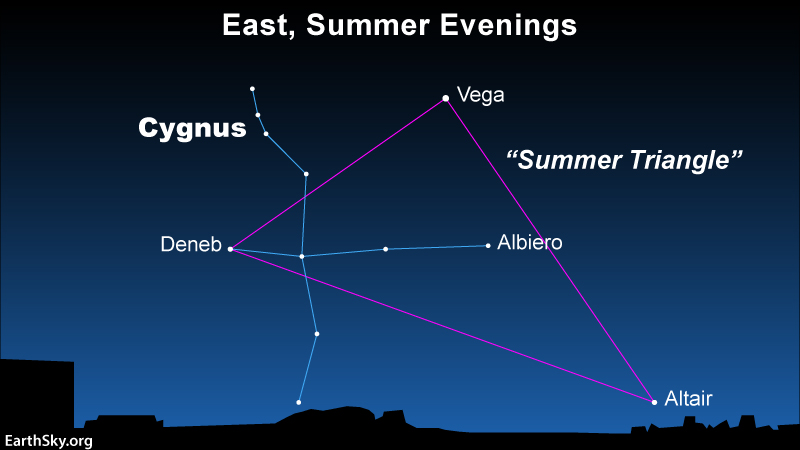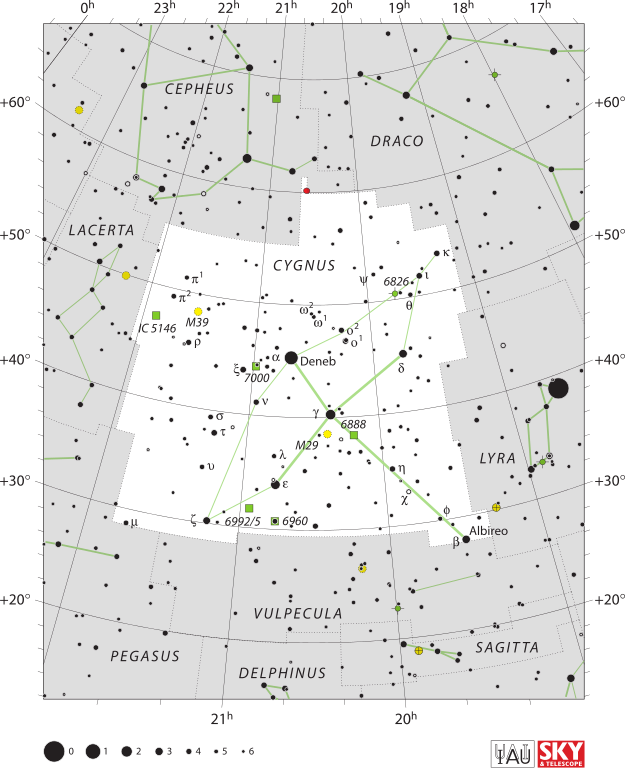
Albireo offers a beautiful color contrast
Albireo, also known as Beta Cygni, is the 2nd-brightest star in the constellation Cygnus the Swan. At first glance, it doesn’t particularly stand out. But viewing this star through a small telescope can take your breath away. It resolves into a striking double, with one component a lovely gold star and the other a dimmer blue close by.
From our perspective, the two stars appear close in the sky, but it’s unknown if they’re gravitationally bound to each other. Regardless, the color contrast between the two is so striking that Albireo is one of the most beautiful double stars in the heavens.

How to find Albireo
How can you spot Albireo in the night sky? It’s easy to find, if you can locate Cygnus the Swan. Cygnus has an easy-to-recognize shape, that of a cross. The constellation is also known as the asterism of the Northern Cross. The brightest star in Cygnus – Deneb – marks the head of the Cross or the Tail of the Swan. Albireo marks the base of the Cross or the Head of Cygnus.
And how can you see Albireo as two stars? They’re best viewed at 30X (“30 power” or a magnification of 30). Unless you have exceedingly powerful binoculars, mounted on a tripod, binoculars won’t show you Albireo as two stars. But any small telescope will. When you see Albireo as two stars, be sure to notice the striking color contrast between the two.

Science of Albireo
The brighter, golden star – Albireo A – is about 420 light-years away. Albireo B, the dimmer blue star, is around 400 light-years distant. Although this is not confirmed, Albireo A and B are most likely an optical double star and not a physical binary system.
On the other hand, Albireo A is a binary star, with two stars so close together that you can’t see them as separate. The Albireo A binary star system has an orbital period of 121.6 years. The brighter star is responsible for the gold color you see through a telescope. It’s a red supergiant star, about 5 times the mass of the sun. It shines at magnitude 3.21. And it outshines its fainter companion, a hot main sequence star that’s 2.7 times the sun’s mass.
Furthermore, in a recent analysis of the Albireo A binary system, astronomers were surprised to find that there may be more stars in the system, possibly making Albireo A a triple or quadruple star system.
Albireo B, the fainter blue star of the pair when viewed through a small telescope, appears just 34 arc seconds away from gold-colored Albireo A. It’s a hot blue star, about 3.7 times the sun’s mass. It shines at magnitude 5.11. If it is a physical companion star to Albireo A, their orbital period would take about 100,000 years.
Bottom line: Albireo, in the constellation Cygnus, is a favorite for stargazers. Through a small telescope, it appears as a beautiful golden star with a dimmer blue companion.
The post Exquisite Albireo, a colorful double star first appeared on EarthSky.
from EarthSky https://ift.tt/It7geWU

Albireo offers a beautiful color contrast
Albireo, also known as Beta Cygni, is the 2nd-brightest star in the constellation Cygnus the Swan. At first glance, it doesn’t particularly stand out. But viewing this star through a small telescope can take your breath away. It resolves into a striking double, with one component a lovely gold star and the other a dimmer blue close by.
From our perspective, the two stars appear close in the sky, but it’s unknown if they’re gravitationally bound to each other. Regardless, the color contrast between the two is so striking that Albireo is one of the most beautiful double stars in the heavens.

How to find Albireo
How can you spot Albireo in the night sky? It’s easy to find, if you can locate Cygnus the Swan. Cygnus has an easy-to-recognize shape, that of a cross. The constellation is also known as the asterism of the Northern Cross. The brightest star in Cygnus – Deneb – marks the head of the Cross or the Tail of the Swan. Albireo marks the base of the Cross or the Head of Cygnus.
And how can you see Albireo as two stars? They’re best viewed at 30X (“30 power” or a magnification of 30). Unless you have exceedingly powerful binoculars, mounted on a tripod, binoculars won’t show you Albireo as two stars. But any small telescope will. When you see Albireo as two stars, be sure to notice the striking color contrast between the two.

Science of Albireo
The brighter, golden star – Albireo A – is about 420 light-years away. Albireo B, the dimmer blue star, is around 400 light-years distant. Although this is not confirmed, Albireo A and B are most likely an optical double star and not a physical binary system.
On the other hand, Albireo A is a binary star, with two stars so close together that you can’t see them as separate. The Albireo A binary star system has an orbital period of 121.6 years. The brighter star is responsible for the gold color you see through a telescope. It’s a red supergiant star, about 5 times the mass of the sun. It shines at magnitude 3.21. And it outshines its fainter companion, a hot main sequence star that’s 2.7 times the sun’s mass.
Furthermore, in a recent analysis of the Albireo A binary system, astronomers were surprised to find that there may be more stars in the system, possibly making Albireo A a triple or quadruple star system.
Albireo B, the fainter blue star of the pair when viewed through a small telescope, appears just 34 arc seconds away from gold-colored Albireo A. It’s a hot blue star, about 3.7 times the sun’s mass. It shines at magnitude 5.11. If it is a physical companion star to Albireo A, their orbital period would take about 100,000 years.
Bottom line: Albireo, in the constellation Cygnus, is a favorite for stargazers. Through a small telescope, it appears as a beautiful golden star with a dimmer blue companion.
The post Exquisite Albireo, a colorful double star first appeared on EarthSky.
from EarthSky https://ift.tt/It7geWU

Aucun commentaire:
Enregistrer un commentaire